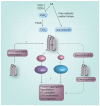Thromboxane and the thromboxane receptor in cardiovascular disease
- PMID: 20543887
- PMCID: PMC2882156
- DOI: 10.2217/clp.10.11
Thromboxane and the thromboxane receptor in cardiovascular disease
Abstract
Thromboxane A(2) (TXA(2)), the primary product of COX-1-dependent metabolism of arachidonic acid, mediates its biological actions through the TXA(2) receptor, termed the TP. Irreversible inhibition of platelet COX-1-derived TXA(2) with low-dose aspirin affords protection against primary and secondary vascular thrombotic events, underscoring the central role of TXA(2) as a platelet agonist in cardiovascular disease. The limitations associated with aspirin use include significant gastrointestinal toxicity, bleeding complications, potential interindividual response variability and poor efficacy in some disease states. This, together with the broad role of TXA(2) in cardiovascular disease beyond the platelet, has refocused interest towards additional TXA(2)-associated drug targets, in particular TXA(2) synthase and the TP. The superiority of these agents over low-dose aspirin, in terms of clinical efficacy, tolerability and commercial viability, remain open questions that are the focus of ongoing research.
Figures

References
-
- Smyth EM, FitzGerald GA. Prostaglandin mediators. In: Bradshaw RA, Dennis EA, editors. Handbook of Cell Signaling. Second Edition Academic Press; UK: 2009. pp. 1219–1228.
-
- Hirata M, Hayashi Y, Ushikubi F, et al. Cloning and expression of cDNA for a human thromboxane A2 receptor. Nature. 1991;349:617–620. - PubMed
-
- Fitzgerald DJ, Roy L, Catella F, et al. Platelet activation in unstable coronary disease. N. Engl. J. Med. 1986;315:983–989. - PubMed
Grants and funding
LinkOut - more resources
Full Text Sources
Other Literature Sources
